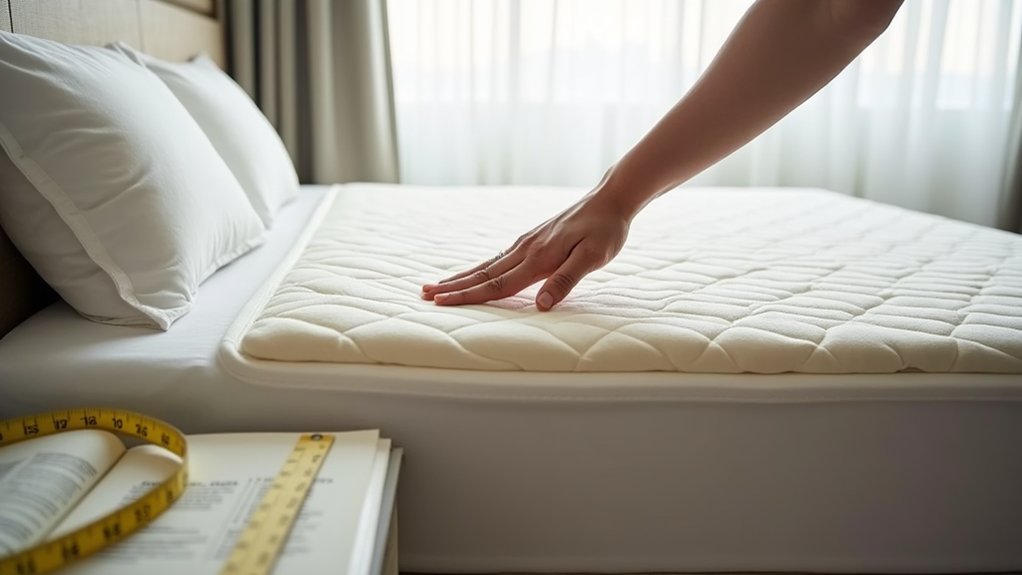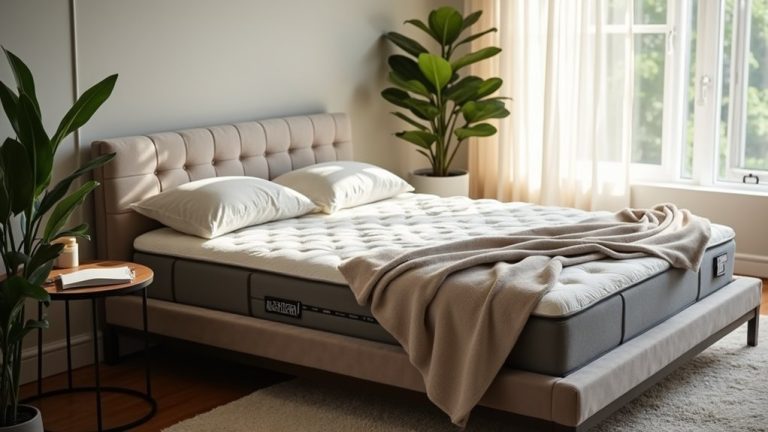What to Look for When Choosing a Memory Foam Mattress
When you're selecting a memory foam mattress, you're not just looking for comfort; you're considering key factors that influence your sleep quality. You'll want to evaluate foam density, firmness levels, and thickness to match your personal preferences and body type. Don't forget about temperature regulation features and motion isolation to minimize disruptions during the night. As you weigh these aspects, you might find yourself wondering how warranty and sleep trial policies can protect your investment. What other considerations could greatly impact your choice?
Foam Density
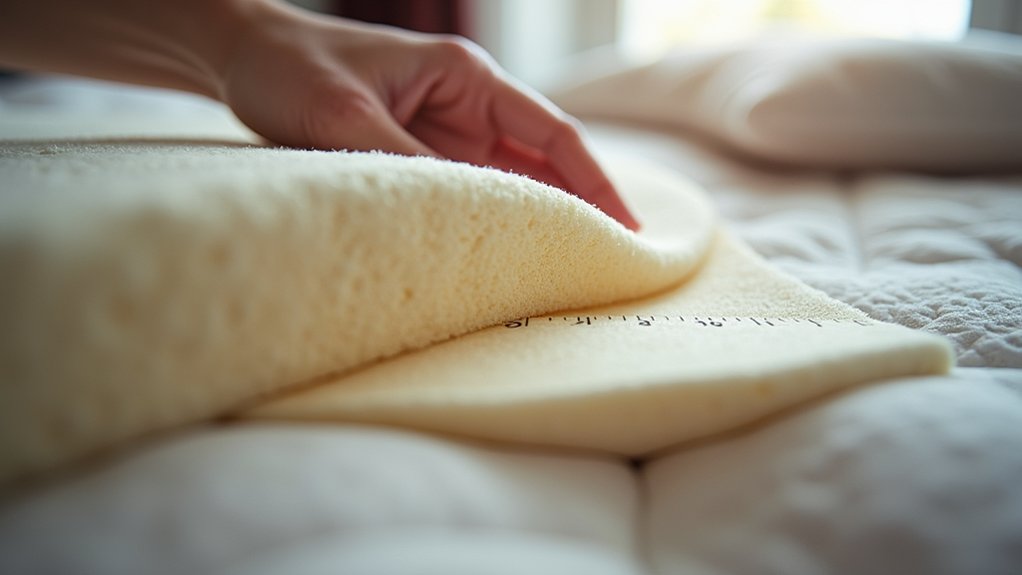
When it comes to choosing a memory foam mattress, understanding foam density is vital. Foam density is measured in pounds per cubic foot (PCF) and varies across three categories: low-density (under 3 PCF), medium-density (3 to 5 PCF), and high-density (over 5 PCF).
- Mass and Volume: Density reflects the mass of the foam compared to its volume, indicating how heavy the foam is for its size.
- Particle Distribution: Higher density means more particles per cubic foot, enhancing resilience and support.
Effects of Density on Mattress Performance:
- Durability: High-density foams last longer, while low-density options may wear out faster.
- Breathability and Responsiveness: Low-density foams are generally more breathable but can retain heat.
- Support and Pressure Relief: High-density foams excel in providing support, especially for pressure points like hips, making them ideal for those seeking minimal impressions.
Choosing the Right Density:
- Sleep Preferences: Medium-density foams offer a balance of comfort and support.
- Body Type: Heavier individuals benefit from high-density foams, while lighter individuals might prefer lower densities.
Understanding these factors is essential in selecting the right mattress for your needs.
Mattress Thickness
Finding the right mattress thickness is essential for achieving a comfortable sleep experience. Memory foam mattresses typically range from 6 to 14 inches thick, with each thickness offering distinct advantages.
General Thickness Guidelines
- 6-8 inches: Ideal for lighter individuals (under 150 lbs) seeking affordability and ease of movement.
- 9-12 inches: Suited for average-weight sleepers (150-230 lbs), providing a balanced combination of support and cushioning.
- 12-14 inches: Best for heavier individuals (over 230 lbs), offering enhanced support and pressure relief. Higher density mattresses in this range also contribute to better durability.
Sleeping Position Considerations
- Side Sleepers: Should opt for thicker mattresses (12-14 inches) to alleviate pressure on hips and shoulders.
- Back and Stomach Sleepers: May find medium thickness (9-12 inches) more comfortable, as it prevents excessive sinkage.
Durability Insights
Thinner mattresses (6-8 inches) often lack durability compared to medium (9-12 inches) and thicker options (13-14 inches).
The right thickness not only enhances your sleep experience but also contributes to the longevity of the mattress, ensuring you receive adequate support for years.
Temperature Regulation
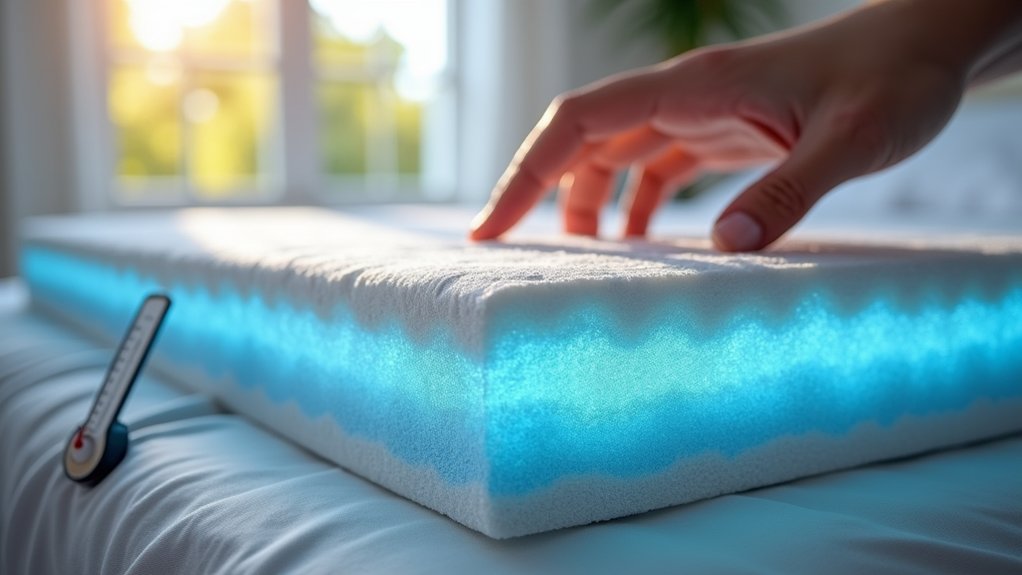
Proper temperature regulation is essential for a good night's sleep, especially if you're prone to overheating. Traditional memory foam mattresses tend to trap body heat due to their closed-cell structure. This heat retention can disrupt your body's natural thermoregulation, making it hard to achieve deep, restful sleep.
To combat this issue, consider mattresses with cooling technologies. Gel-infused memory foam is one option designed to wick away heat and moisture. The gel breaks up the dense, heat-absorbing surface, providing a cooler sleeping experience. Not all memory foams retain heat equally; some newer models incorporate cooling technologies that address heat retention effectively.
Another advanced solution is phase change materials (PCMs). These materials adapt to your body temperature, storing heat when necessary and releasing it to maintain comfort. Products like Tempur-Pedic's PRObreeze and LUXEbreeze employ PCMs for effective temperature control.
Additionally, look for mattresses with copper-infused foam and heat-dissipating covers that draw heat away from your body. Hybrid mattresses featuring pocketed coils promote airflow, enhancing temperature regulation.
Natural materials such as cotton and Merino wool in covers further aid in maintaining a balanced temperature. Prioritizing these features will help you find a mattress that keeps you cool throughout the night.
Edge Support
Edge support plays an essential role in determining how stable and usable your mattress is, especially at the borders where you sit or lie. Understanding edge support helps you evaluate the mattress's overall performance.
Materials and Construction
- All-foam mattresses typically offer poorer edge support due to the conforming nature of memory foam and polyfoam.
- Softer comfort layers compress under weight, leading to less stability at the edges.
- Thicker comfort layers can amplify sinkage, further reducing edge stability.
Types of Mattresses
- Innerspring and hybrid mattresses generally excel in edge support thanks to their coil systems.
- Latex mattresses, especially those with Dunlop latex, often perform well in this regard.
- All-foam models score lower, but firmer versions with thinner comfort layers may provide exceptions.
Reinforcements
- Reinforced edges, such as those made with sturdy coils or dense foam, enhance support and minimize sagging.
- Pocketed coils encased in edge foam deliver additional stability.
Practical Considerations
- Strong edge support increases the mattress's usable surface area, facilitating easier access and improving longevity. Additionally, strong edge support can help reduce sagging and enhance mattress structure over time.
- If edge support is lacking, you may need to adjust your sleeping position to avoid instability.
Firmness Levels
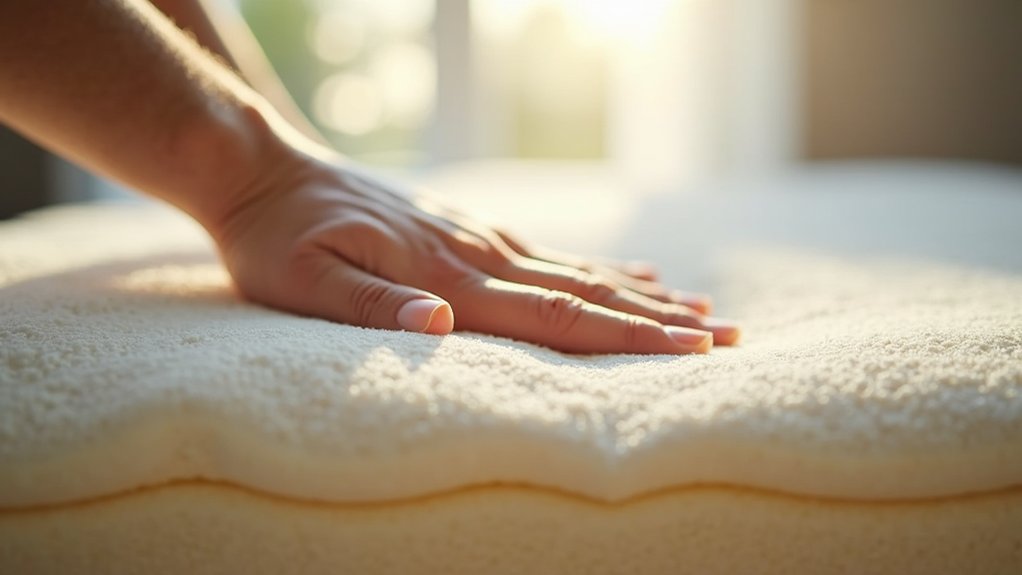
When choosing a mattress, firmness levels greatly impact your comfort and support. Firmness is typically measured on a 1-10 scale, where 1 is the softest and 10 is the firmest.
Here's a breakdown of the firmness categories:
- Extra Soft (1-2): Extremely plush with considerable sinkage, generally too soft for most sleepers.
- Soft (3-4): Offers a plush feel with noticeable contouring, suitable for side and lighter-weight sleepers.
- Medium (5-6): Provides moderate sinkage and conforming, ideal for most sleepers.
- Medium Firm (6-7): Balances support and pressure relief with minimal sinkage.
- Firm (7-8): Offers rigid support with virtually no sinkage.
Your body weight and sleeping position greatly influence the best firmness for you. Lighter individuals, weighing less than 130 pounds, often prefer softer mattresses for pressure relief. In contrast, heavier sleepers may benefit from firmer options for adequate support. Average firmness preferences vary by body weight, with side sleepers typically requiring softer to medium-soft options for cushioning, while back and stomach sleepers usually need medium to medium-firm mattresses to maintain spinal alignment.
Understanding these nuances helps guarantee you select the right firmness level for ideal sleep quality.
Additional Considerations
Choosing the right firmness level is only part of the equation when selecting a memory foam mattress. You should also consider the following factors that can impact your sleeping experience.
Heat Retention and Cooling Features
Memory foam is known for heat retention, which can lead to a warmer sleep environment. To counter this, look for:
- Gel-infused foam: This helps dissipate heat.
- Breathable covers: These improve ventilation and reduce heat buildup.
- Advanced cooling technologies: Newer models often incorporate these features.
Initial Odor and Off-Gassing
New mattresses may emit a chemical smell called off-gassing. While this odor typically fades in a few days, it can be bothersome. To minimize it:
- Ventilate the room: Allow fresh air to circulate.
- Choose high-quality foam: These generally have less off-gassing.
Weight and Portability
Memory foam mattresses can be heavier than others, making them challenging to move or rotate. Keep in mind:
- High-density foam: This offers durability but adds weight.
- Consider lighter options: Some brands provide designs that are easier to handle.
Edge Support and Stability
All-foam mattresses tend to have lower edge support. For better stability:
– Select firmer models: They often offer improved edge support.
Warranty and Sleep Trials
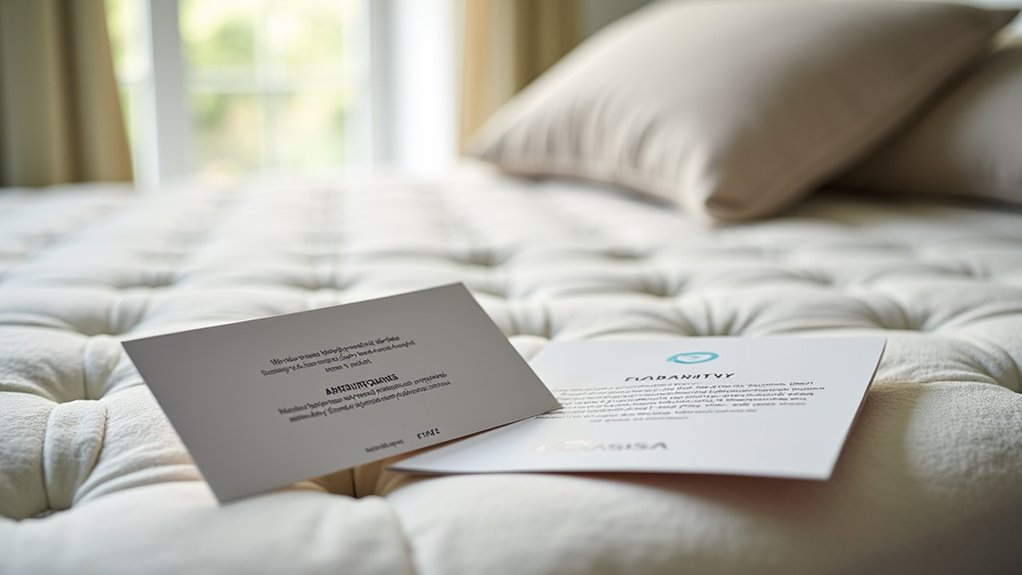
A solid warranty and a generous sleep trial can provide peace of mind when investing in a memory foam mattress. Understanding these components is essential for making an informed decision.
Warranty Length and Coverage
- Duration: Warranties typically last between 10 to 20 years, with some covering the mattress's entire lifespan.
- Start Date: Coverage begins on the purchase or delivery date.
- What's Covered: Look for warranties that cover defects in materials and workmanship. Be aware that normal wear and tear usually isn't included, and permanent body impressions of 1 inch or greater are covered under the Slumber Solutions® warranty.
Types of Warranty Coverage
- Repair: Some manufacturers will repair fixable components.
- Replacement: If the mattress is beyond repair, it may be replaced.
- Refund/Store Credit: Certain brands offer refunds or store credit for a future purchase.
- Limited vs. Lifetime: Limited warranties cover specific defects for a defined period, while lifetime warranties offer coverage for the mattress's lifetime.
Sleep Trial Length
- Duration: Most sleep trials last between 90 to 120 nights, although some can extend to a year.
- Return Policy: You can return or exchange the mattress during this period if unsatisfied, allowing for thorough testing.
Motion Isolation
Investing in a memory foam mattress goes beyond just warranty and sleep trials; it's important to contemplate how well a mattress can isolate motion. Motion isolation refers to the mattress's ability to prevent movement on one side from affecting the other side. This feature is particularly valuable for couples or restless sleepers.
Material and Construction
- Memory foam excels at absorbing movement due to its contouring properties, which respond to heat and pressure. Additionally, high-density foam layers are essential for optimal motion isolation performance.
- All-foam mattresses typically provide superior motion isolation, thanks to high-density polyfoam cores.
- Hybrid mattresses with individually-encased coils can also minimize motion transfer, although not as effectively as all-foam models.
Testing and Evaluation
- Motion isolation is evaluated by placing an object, like a wine glass, on the mattress and observing its stability during movement.
- Standardized tests measure how weight applied on one side affects the opposite side, ensuring accurate comparisons.
Benefits
- Effective motion isolation enhances sleep quality by reducing disturbances from a partner's movements.
- Consider additional features, such as thick comfort layers or pocketed coils, to improve performance in this area.
Understanding these factors will help you choose a mattress that meets your motion isolation needs.
